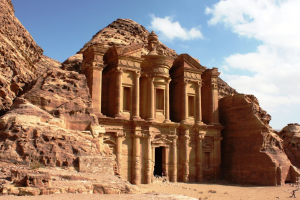Eight Wonders of the World
Exploring the eight wonders of the world is an endeavor that feeds our curiosity and leaves us in awe of human creativity and nature’s grandeur. From ancient marvels to modern architectural feats, the top eight wonders of the world have captivated travelers for generations. In this comprehensive travel guide, we’ll take you on a journey to discover these extraordinary destinations.
The Great Pyramid of Giza: A Glimpse into Ancient Egypt
Unveiling the Pyramid’s Mysteries
The Great Pyramid of Giza stands as an awe-inspiring testament to the advanced engineering and architectural prowess of ancient Egypt. Shrouded in mystery and intrigue, this colossal structure has captured the imagination of historians, archaeologists, and travellers for centuries. But what secrets lie beneath its majestic exterior?
The Pyramid Complex: A Fascinating Legacy
The Giza Pyramid complex, comprising the Great Pyramid and its two companions, the Pyramid of Khafre and the Pyramid of Menkaure, is a complex that embodies the ancient Egyptians’ beliefs and cultural practices. The precision with which these structures were constructed reflects the deep understanding the Egyptians had of astronomy and mathematics.
The Enigma of Construction Techniques
One of the most perplexing aspects of the Great Pyramid is the method of its construction. The immense size of the stones used in its construction raises questions about how the ancient Egyptians were able to transport and lift these massive blocks. Some theories suggest the use of ramps, while others propose more intricate systems involving waterways and counterweights. Also, read about the Beaches of Las Vegas
The Colosseum: Where History Comes Alive
Gladiatorial Combat and Entertainment
The Colosseum, a symbol of ancient Rome’s grandeur, is synonymous with gladiatorial combat and captivating spectacles. This monumental amphitheater played host to battles between gladiators, wild animal hunts, and dramatic reenactments, captivating the hearts of the Roman populace.
Architectural Ingenuity of Ancient Rome
The architectural brilliance of the Colosseum lies not only in its grandeur but also in its innovative design. The tiered seating, underground chambers, and retractable awnings showcase the Romans’ mastery of engineering and construction techniques, allowing for the seamless execution of various events.
Preserving the Colosseum for Future Generations
Despite the passage of millennia, the Colosseum continues to stand as a testament to the enduring legacy of ancient Rome. Restoration efforts and ongoing preservation projects are dedicated to maintaining this iconic structure’s integrity, ensuring that generations to come can marvel at its historical significance.
Machu Picchu: Inca Majesty Amidst the Andes
The Lost City’s Rediscovery
Hidden amidst the mist-shrouded Andes, Machu Picchu remained a secret until its rediscovery in 1911 by American historian Hiram Bingham. This archaeological wonder offers a glimpse into the Inca civilization’s advanced urban planning and architectural expertise.
Architectural Marvels of Machu Picchu
The layout of Machu Picchu, with its intricate terraces, temples, and residential areas, showcases the Inca’s harmonious integration of architecture with the surrounding natural landscape. The precision of stone-cutting and construction techniques used here exemplifies the Inca’s reverence for their environment.
Spiritual Significance and Cultural Heritage
Machu Picchu’s spiritual significance is evident in its sacred structures and astronomical alignment. Believed to be a center of worship and celestial observation, the site embodies the Inca’s deep connection with nature and the cosmos.

Chichen Itza: Echoes of the Mayan Civilization
El Castillo: Pyramid of Kukulkan
The Pyramid of Kukulkan, also known as El Castillo, stands as the centerpiece of Chichen Itza. Its symmetrical design and mathematical precision align with the Mayan calendar, creating a stunning visual representation of astronomical knowledge.
Astronomical Wonders of Chichen Itza
Chichen Itza’s architecture reflects the Mayan civilization’s astronomical sophistication. During the equinoxes, the sunlight creates the illusion of a serpent slithering down El Castillo’s staircase—a remarkable testament to the Mayans’ understanding of celestial events.
Mayan Calendar and Equinox Phenomenon
Chichen Itza’s alignment with the Mayan calendar is evident in its structures. The equinox phenomenon at El Castillo reflects the Mayans’ intricate grasp of celestial cycles, marking the passage of time with both accuracy and reverence.
Petra: Carved Splendor in the Desert
The Rose City’s Hidden Treasures
Carved into the rose-red cliffs of southern Jordan, Petra is a city of mesmerizing beauty and historical significance. Its intricate rock-cut architecture and hidden treasures tell the story of the Nabatean civilization’s prosperity and ingenuity.
Nabatean Architecture and Trade Hub
Petra’s architecture serves as a testament to the Nabateans’ mastery of water management and trade. The intricate water channels and elaborate facades highlight their ability to adapt and thrive in a challenging desert environment.
The Siq: Gateway to Petra’s Magnificence
The Siq, a narrow gorge that serves as the entrance to Petra, is a remarkable example of how the Nabateans integrated their city with the surrounding landscape. As visitors walk through the winding passage, they are greeted with awe-inspiring views of Petra’s architectural marvels.

Taj Mahal: A Monument to Eternal Love
Symbolism and History Behind the Taj Mahal
The Taj Mahal, a symbol of enduring love, was built by Mughal Emperor Shah Jahan in memory of his beloved wife Mumtaz Mahal. Its architectural beauty and intricate craftsmanship make it a UNESCO World Heritage site and a testament to the Mughal dynasty’s opulence.
Architectural Marvels in Marble
The Taj Mahal’s stunning white marble facade is adorned with intricate inlays of semi-precious stones, showcasing the Mughal artisans’ mastery of craftsmanship. The symmetrical design and meticulous detailing reflect a perfect blend of Islamic, Persian, and Indian architectural styles.
Captivating Gardens and Reflections
The Taj Mahal’s surrounding gardens, water channels, and reflective pools create a harmonious and serene ambiance. The famous reflection of the monument in the central pool adds to the site’s ethereal beauty, evoking a sense of tranquillity and contemplation.
Christ the Redeemer: Embracing Rio’s Splendor
Iconic Symbol of Rio de Janeiro
Perched atop the Corcovado Mountain, the Christ the Redeemer statue is an iconic symbol of Rio de Janeiro and a testament to the city’s rich cultural heritage. Its outstretched arms embrace the city below, offering panoramic views of the vibrant metropolis and its stunning coastline.
Engineering and Awe-Inspiring Views
The engineering marvel of Christ the Redeemer lies in its innovative design and strategic placement. The statue’s reinforced concrete and soapstone exterior withstand the test of time while offering visitors breathtaking views of Rio’s urban landscape and natural beauty.
Spiritual Significance and Global Recognition
Beyond its architectural and engineering significance, Christ the Redeemer holds deep spiritual importance for the people of Brazil. It represents faith, unity, and hope, resonating with individuals worldwide and transcending cultural and religious boundaries. Read more about Bukchon Hanok Village: Traditional Korean Architecture
The Great Wall of China: Ancient Defensive Wonder
Spanning the Chinese Landscape
The Great Wall of China, an architectural wonder that stretches thousands of miles, is a testament to the perseverance and ingenuity of the Chinese people. Built to protect against invasions, it spans diverse terrains, from rugged mountains to expansive deserts.
Construction Methods and Historical Significance
The construction of the Great Wall involved an amalgamation of labor, materials, and strategic planning. Various dynasties contributed to its expansion, leaving behind a historical narrative of China’s defense strategies and societal changes.
Exploring the Wall’s Sections
The Great Wall is not a singular structure but a collection of interconnected walls and fortifications. Each section has its own unique characteristics, reflecting the geographical and cultural nuances of the regions it traverses. Visitors can explore its history while enjoying breathtaking views.

Conclusion
These monumental structures from around the world offer more than just architectural marvels; they provide insights into the civilizations that built them. From the ancient Egyptians’ celestial knowledge to the Mayans’ intricate calendars and the Mughals’ artistic splendor, these wonders are a testament to human innovation, creativity, and the pursuit of enduring legacies.
FAQs
What is the significance of the Great Pyramid’s alignment?
The alignment of the Great Pyramid with the true north is believed to have symbolic and astronomical significance, possibly related to the Egyptians’ spiritual beliefs and celestial observations.
Can visitors still explore the Colosseum’s underground chambers?
Yes, visitors have the opportunity to explore the Colosseum’s underground chambers, which once housed gladiators and animals before they entered the arena.
What makes Machu Picchu a spiritual site?
Machu Picchu’s layout aligns with significant astronomical events, suggesting its use as a site for spiritual ceremonies and celestial observations by the Inca civilization.
How did the Nabateans manage water in Petra’s desert environment?
The Nabateans ingeniously engineered a complex system of water channels and cisterns to collect and manage water, allowing Petra to thrive in an otherwise arid landscape.
What inspired the design of Christ the Redeemer?
The Christ the Redeemer statue was inspired by the concept of Christ’s open arms as a symbol of welcome, unity, and protection for the people of Rio de Janeiro and beyond.
